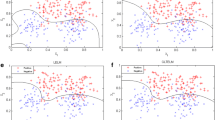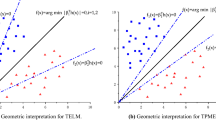Abstract
In this paper, we suggest a novel approach termed as regularized based implicit Lagrangian twin extreme learning machine in primal as a pair of unconstrained convex minimization problem (RILTELM) where regularization term is added to follow the structural risk minimization principle. Here, we consider 2-norm of the slack vector of variables to make the problem strongly convex which results in a unique solution. Since it has non-smooth plus functions in their objective function, so we find an approximate solution by replacing the non-smooth plus function with smooth approximation function because to find an approximation solution in primal space is always superior to its dual. Due to non-smooth plus function, we solve the problem by either smooth approximation approach or generalized derivative approach. In addition, a functional iterative scheme is also suggested to find the optimal solution. Hence, no external optimization toolbox is required unlike in twin extreme learning machine (TELM) and twin support vector machine (TWSVM). The numerical experiments are demonstrated on artificial and real-world datasets and compared with TWSVM, ELM, TELM and LSTELM to establish the efficacy and applicability of proposed RILTELM.















Similar content being viewed by others
References
Aslan MF, Sabanci A, Durdu A (2017) Different Wheat Species Classifier Application of ANN and ELM. J Multidiscipl Eng Sci Technol 4(9):8194–8198
Balasundaram S, Gupta D (2016) On optimization based extreme learning machine in primal for regression and classification by functional iterative method. Int J Mach Learn Cybern 7(5):707–728
Balasundaram S, Gupta D, Kapil S (2014) 1-Norm extreme learning machine for regression and multiclass classification using Newton method. Neurocomputing 128:4–14
Balasundaram S, Gupta D, Prasad SC (2017) A new approach for training Lagrangian twin support vector machine via unconstrained convex minimization. Appl Intell 46:124–134. https://doi.org/10.1007/s10489-016-0809-8
Balasundaram S, Tanveer M (2013) On Lagrangian twin support vector regression. Neural Comput Appl 22(1):257–267
Cortes C, Vapnik V (1995) Support-vector networks. Mach Learn 20(3):273–297
Demsar J (2006) Statistical comparisons of classifiers over multiple data sets. J Mac Learn Rese 7:1–30
Dua D, Karra Taniskidou E (2017) UCI Machine Learning Repository [http://archive.ics.uci.edu/ml]. Irvine, CA: University of California, School of Information and Computer Science (2017)
Fung G, Mangasarian OL (2001) Proximal support vector machine classifiers. In: Proc. Int. Conf. Knowl. Discov. Data Mining, San Francisco, CA, (2001): 77–86
Fung G, Mangasarian OL (2003) Finite Newton method for Lagrangian support vector machine classification. Neurocomputing 55(1–2):39–55
Gautam C, Tiwari A, Tanveer M (2019) "OCKELM+: kernel extreme learning machine based one-class classification using privileged information (or KOC+: Kernel Ridge Regression or Least Square SVM with zero bias based One-class Classification using Privileged Information)." arXiv preprint arXiv:1904.08338
Gu X, Chung F-L, Wang S (2020) Extreme vector machine for fast training on large data. Int J Mach Learn Cybern 11(1):33–53
Gu Y, Chen Y, Liu J, Jiang X (2015) Semi-supervised deep extreme learning machine for Wi-Fi based localization. Neurocomputing 166:282–293
Gupta U, Gupta D (2019) Lagrangian twin-bounded support vector machine based on L2-norm. In: Kalita J, Balas V, Borah S, Pradhan R (eds) Recent developments in machine learning and data analytics, vol 740. Springer, Singapore, pp 431–444
Gupta U, Gupta D, Prasad M (2018) Kernel target alignment based fuzzy least square twin bounded support vector machine. In: IEEE Symposium series on computational intelligence (SSCI). IEEE, pp 228–235
Hiriart-Urruty J-B, Strodiot J-J, Nguyen VH (1984) Generalized Hessian matrix and second-order optimality conditions for problems with C1, data. Applied mathematics and optimization 11(1):43–56
Horata P, Chiewchanwattana S, Sunat K (2013) Robust extreme learning machine. Neurocomputing 102:31–44
Huang G, Huang G-B, Song S, You K (2015) Trends in extreme learning machines: a review. Neural Netw 61:32–48
Huang G, Song S, Gupta JND, Wu C (2014) Semi-supervised and unsupervised extreme learning machines. IEEE Trans Cybern 44(12):2405–2417
Huang G-B, Zhou H, Ding X, Zhang R (2011) Extreme learning machine for regression and multiclass classification. IEEE Trans Syst Man Cybern Part B (Cybernetics) 42(2):513–529
Huang G-B, Chen L (2007) Convex incremental extreme learning machine. Neurocomputing 70(16–18):3056–3062
Huang G-B, Chen L (2008) Enhanced random search based incremental extreme learning machine. Neurocomputing 71(16–18):3460-3468
Huang G-B, Zhu Q-Y, Siew C-K (2006) Extreme learning machine: theory and applications. Neurocomputing 70(1–3):489–501
Huang G-B, Ding X, Zhou H (2010) Optimization method based extreme learning machine for classification. Neurocomputing 74(1–3):155–163
Jayadeva R Khemchandani, Chandra S (2007) Twin support vector machines for pattern classification. IEEE Trans Pattern Anal Mach Intell 29(5):905–910. https://doi.org/10.1109/TPAMI.2007.1068
Jia X, Wang R, Liu J, Powers DMW (2016) A semi-supervised online sequential extreme learning machine method. Neurocomputing 174:168–178
Kongsorot Y, Horata P, Musikawan P, Sunat K (2019) Kernel extreme learning machine based on fuzzy set theory for multi-label classification. Int J Mach Learn Cybern 10(5):979–989
Kumar MA, Gopal M (2009) Least squares twin support vector machines for pattern classification. Expert Syst Appl 36(4):7535–7543
Lan Y, Soh YC, Huang G-B (2010) Constructive hidden nodes selection of extreme learning machine for regression. Neurocomputing 73(16–18):3191–3199
Lee Y-J, Mangasarian OL (2001) SSVM: A smooth support vector machine for classification. Comput Optim Appl 20(1):5–22
Li K, Kong X, Zhi Lu, Wenyin L, Yin J (2014) Boosting weighted ELM for imbalanced learning. Neurocomputing 128:15–21
Li S, Song S, Wan Y (2018) Laplacian twin extreme learning machine for semi-supervised classification. Neurocomputing 321:17–27
Liu J, Patwary MJA, Sun XY, Tao K (2019) An experimental study on symbolic extreme learning machine. Int J Mach Learn Cybern 10(4):787–797
Luo X, Li Y, Wang W, Ban X, Wang J-H, Zhao W (2020) A robust multilayer extreme learning machine using kernel risk-sensitive loss criterion. Int J Mach Learn Cybern 11(1):197–216
Lv F, Han M (2019) Hyperspectral image classification based on multiple reduced kernel extreme learning machine. Int J Mach Learn Cybern 10(12):3397–3405
Ma J, Yang L, Wen Y, Sun Q (2019) Twin minimax probability extreme learning machine for pattern recognition. Knowl-Based Syst 187:104806
Mangasarian OL (2001). Data mining via support vector machines. In: IFIP Conference on system modeling and optimization, pp. 91–112. Springer, Boston, MA, 2001
Mangasarian OL, Musicant DR (2001a) Lagrangian support vector machines. Journal of Mach Learn Res 1:161–177
Mangasarian OL, Musicant DR (2001b) Active support vector machine classification. Adv Neural Inf Process Syst 13:577–583
Miche Y, Sorjamaa A, Bas P, Simula O, Jutten C, Lendasse A (2009) OP-ELM: optimally pruned extreme learning machine. IEEE Trans Neural Netw 21(1):158–162
Musicant DR, Feinberg A (2004) Active set support vector regression. IEEE Trans Neural Netw 15(2):268–275
Peng X (2010) Primal twin support vector regression and its sparse approximation. Neurocomputing 73(16–18):2846–2858
Qi Z, Tian Y, Shi Y (2012) Laplacian twin support vector machine for semi-supervised classification. Neural Netw 35:46–53
Raghuwanshi BS, Shukla S (2019) Classifying imbalanced data using ensemble of reduced kernelized weighted extreme learning machine. Int J Mach Learn Cybern 10(11):3071–3097
Rao CR, Mitra SK (1971) Further contributions to the theory of generalized inverse of matrices and its applications. Sankhyā Indian J Stat Ser A 33(3):289–300
Rastogi R, Bharti A (2019) Least squares twin extreme learning machine for pattern classification. In: Deb D, Balas V, Dey R (eds) Innovations in infrastructure, vol 757. Springer, Singapore, pp 561–571
Rastogi R, Sharma S, Chandra S (2018) Robust parametric twin support vector machine for pattern classification. Neural Process Lett 47(1):293–323
Richhariya B, Gupta D (2019) Facial expression recognition using iterative universum twin support vector machine. Appl Soft Comput 76:53–67
Richhariya B, Tanveer M (2020) A reduced universum twin support vector machine for class imbalance learning. Pattern Recognit. https://doi.org/10.1016/j.patcog.2019.107150
Ripley BD (1994) Neural networks and related methods for classification. J R Stat Soc Ser B (Methodological) 56:409–456
Rozza A, Manzo M, Petrosino A (2014) A novel graph-based fisher kernel method for semi-supervised learning. In: 2014 22nd International Conference on Pattern Recognition (ICPR). IEEE, 2014
Sattar AMA, Ertuğrul ÖF, Gharabaghi B, McBean EA, Cao J (2019) Extreme learning machine model for water network management. Neural Comput Appl 31(1):157–169
Shao Y-H, Zhang C-H, Wang X-B, Deng N-Y (2011) Improvements on twin support vector machines. IEEE Trans Neural Netw 22(6):962–968
Shi L-C, Lu B-L (2013) EEG-based vigilance estimation using extreme learning machines. Neurocomputing 102:135–143
Sun X, Wang Z, Hu J (2017) Prediction interval construction for byproduct gas flow forecasting using optimized twin extreme learning machine. Math Probl Eng 55:1–12
Suykens JAK, Vandewalle J (1999) Least squares support vector machine classifiers. Neural Process Lett 9(3):293–300
Tanveer M (2015) Robust and sparse linear programming twin support vector machines. Cognit Comput 7(1):137–149
Tanveer M, Khan MA, Ho S-S (2016) Robust energy-based least squares twin support vector machines. Applied Intelligence 45:174–186. https://doi.org/10.1007/s10489-015-0751-1
Tran H-N, Cambria E (2018) Ensemble application of ELM and GPU for real-time multimodal sentiment analysis. Memetic Comput 10(1):3–13
Wan Y, Song S, Huang G, Li S (2017) Twin extreme learning machines for pattern classification. Neurocomputing 260:235–244
Wang W, Gan Y, Vong CM et al (2020) Homo-ELM: fully homomorphic extreme learning machine. Int J Mach Learn Cyber 11:1531–1540. https://doi.org/10.1007/s13042-019-01054-w
Wong SY, Yap KS, Yap HJ (2016) A Constrained Optimization based Extreme Learning Machine for noisy data regression. Neurocomputing 171:1431–1443
Yang Z-X, Wang X-B, Wong PK (2018) Single and Simultaneous Fault Diagnosis with Application to a Multistage Gearbox: A Versatile Dual-ELM Network Approach. IEEE Trans Industr Inf 14:5245–5255
Yu Q, Miche Y, Eirola E, Van Heeswijk M, SéVerin E, Lendasse A (2013) Regularized extreme learning machine for regression with missing data. Neurocomputing 102:45–51
Yuan Y, Wang Y, Cao F (2011) Optimization approximation solution for regression problem based on extreme learning machine. Neurocomputing 74(16):2475–2482
Zhou W, Qiao S, Yi Y, Han N, Chen Y, Lei G (2020) Automatic optic disc detection using low-rank representation based semi-supervised extreme learning machine. Int J Mach Learn Cybern 11(1):55–69
Zhu Q-Y, Kai Qin A, Suganthan PN, Huang G-B (2005) Evolutionary extreme learning machine. Pattern Recognit 38(10):1759–1763
Zhang G, Cui D, Mao S et al (2020) Unsupervised feature learning with sparse Bayesian auto-encoding based extreme learning machine. Int J Mach Learn Cyber 11:1557–1569. https://doi.org/10.1007/s13042-019-01057-7
Zong W, Huang G-B, Chen Y (2013) Weighted extreme learning machine for imbalance learning. Neurocomputing 101:229–242
Author information
Authors and Affiliations
Corresponding author
Ethics declarations
Conflict of interest
Authors have no conflict of interest.
Additional information
Publisher's Note
Springer Nature remains neutral with regard to jurisdictional claims in published maps and institutional affiliations.
Rights and permissions
About this article
Cite this article
Gupta, U., Gupta, D. Regularized based implicit Lagrangian twin extreme learning machine in primal for pattern classification. Int. J. Mach. Learn. & Cyber. 12, 1311–1342 (2021). https://doi.org/10.1007/s13042-020-01235-y
Received:
Accepted:
Published:
Issue Date:
DOI: https://doi.org/10.1007/s13042-020-01235-y




